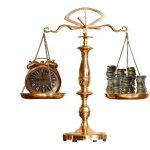Depreciation (also known as amortization) refers to the gradual and permanent decrease in value of the assets (referred to as a depreciable asset) of a firm, nation or individual over its lifetime.
An asset can depreciate for many reasons such as due to wear and tear or it has become obsolete.
Depreciation is a necessary concept because as a company buys a fixed asset (such as new equipment), management expects the asset to be useful and generate the necessary revenues over time.
Another reason for depreciation is that without it, fixed assets in the balance sheet will be overstated. For example the market value of a 5-year-old piece of equipment is not worth the same as when it was purchased brand new.
How to calculate Depreciation
In order to calculate depreciation, four values are needed:
(i) Initial cost of the asset;
(ii) Expected salvage value of the asset (which refers to the value of the asset when it can no longer be used in production. For example, an asset can be sold for spare parts or metallic contents after it is retired from its original function.)
(iii) Estimated useful life of the asset;
(iv) A specific method of apportioning the cost of over the life (which will de discussed below).
Different types of Depreciation Methods
(a) Straight Line Depreciation
Straight line depreciation is the most often used technique and also the simplest.
The owner of the asset estimates the salvage value of the asset at the end of its useful life and expenses a portion of the original cost in equal proportions over that period and is calculated as follows:
For example, a Pizzeria purchases a new oven that is expected to perform at an optimal level for 8 years, for a cost of $8,000. After the 8 years, the oven can be sold for spare parts for $750.
Annual Depreciation Expense = ($8,000 – $750) / 8 years = $906.25
The depreciation figure implies that the book value of the oven as represented in the fixed assets portion of the balance sheet loses $906.25 in value each year.
After 1 year, the owner of the Pizzeria would list the oven has having a value of $8,000-$906.25 = $7093.75.
The second year it would be $ 8000 – (2 x $906.25) = $6,187.50, and so on.
(b) Declining-Balance Method
A Declining-Balance Method is an accelerated depreciation method and implies that the asset loses the majority of its value in the first few years of its useful life, since most assets perform optimally in the first few years.
The salvage value is not used in the calculation, as the Declining Balance Method assumes that the depreciation value at the end of the life is higher than the salvage value.
The annual depreciation rate is calculated as:
Annual Depreciation = Previous year’s value
For example, the same Pizzeria has expanded its business and now offers a delivery service.
Depreciation Example
The owner brought a brand new car for $20,000, and expects to use the car for 5 years before being replaced. The asset depreciates by a factor of 1/N as follows:
| Year | Depreciation | Year –end Value |
| 1 | [$20,000/5]=$4,000 | $20,000-$4,000=$16,000 |
| 2 | [$16,000/5]=$3,200 | $16,000-$3,200=$12,800 |
| 3 | [$12,800/5]=$2,560 | $12,800-$2,560=$10,240 |
| 4 | [$10,240/5]=$2,048 | $10,240-$2,048=$8,192 |
| 5 | [$8,192/5]=$1638.4 | $8,192-$1638.4=$6553.6 |
(c) Activity Depreciation
Activity Depreciation is based on level of activity rather than time.
When the asset is originally purchased, its lifetime use is estimated in terms of the level of activity.
Returning to the Pizzeria example, the owner assumes that their delivery car will be used for 60,000 miles, and can be sold for spare parts for $1,000.
The per-mile depreciation rate is calculated as:
Depreciation per mile = (Cost – Salvage) / Total miles
Depreciation per mile = ($20,000 – $1,000) / 60,000 miles = $0.316 per mile
If after 1 year, the car has been used for 13,000 miles the car would have depreciated by:
$0.316*13,000 = $4,108
Thus, having a book value of:
($20,000 – $1,000 – $4,108) = $14,892.
Conclusion
The proper use of conservative and accurate depreciation rates are of concern to a company’s management.
Different accounting rules allow assets to be written off over different periods of time, and at different rates.
A public company should explain clearly which depreciation method is used in the company’s annual 10K filling (annual report of a company’s performance), as different depreciation methods result in large differences.
 Bond
Bond Call Option
Call Option
